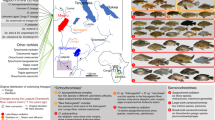Abstract
CHARACTER divergence between sympatric, ecologically similar species has been attributed to selection which tends to increase the ecological difference between such species and to reduce the zone of their ecological overlap1. Evidence for this phenomenon is based solely on morphological Characters which are presumably controlled by a number of genetic factors. There is, however, no documentation of divergence between sympatric species at the allelic level. During the course of a study of the population genetics of the intertidal limpet Acmaea pelta, I discovered what seemed to be an effect of coexistence with congeners on the frequencies of allozymes at a leucine aminopeptidase (Lap) locus. Populations of this highly eurytopic species from habitats offering widely different algal food and physical conditions, had similar frequencies of Lap allozymes, except from habitats where the populations were mixed with large populations of another acmaeid species (unpublished results).
This is a preview of subscription content, access via your institution
Access options
Subscribe to this journal
Receive 51 print issues and online access
$199.00 per year
only $3.90 per issue
Buy this article
- Purchase on Springer Link
- Instant access to full article PDF
Prices may be subject to local taxes which are calculated during checkout
Similar content being viewed by others
References
Mayr, E., Populations, Species, and Evolution, 51–54 (Belknap, Cambridge, Massachusetts, 1970).
Test, A. R., Ecology, 26, 395–405 (1945).
Ricketts, E. F., and Calvin, J., Between Pacific Tides (revised ed.) (Stanford University Press, Stanford, 1952).
Shaw, C. R., Brookhaven Symp. Biol., 17, 117–127 (1964).
Smithies, O., Biochem. J. 71, 585–587 (1959).
Brewer, G. J., Introduction to Isozyme Techniques (Academic, New York, 1970).
Haven, S. B., Ecology, 54, 143–151 (1973).
Koehn, R. K., and Mitton, J. B., Am. Nat. 106, 47–56 (1972).
MacArthur, R. H., and Levins, R., Proc. natn. Acad. Sci. U.S.A., 51, 1207–1210 (1964).
Siegel, S., Nonparametric Statistics for the Behavioral Sciences, 127–136 (McGraw-Hill, New York, 1956).
Crozier, R. H., Am. Zool., 14, 1151–1157 (1974).
Giesel, J. T., Evolution, 24, 98–119 (1970).
Frank, P. W., Ecology, 46, 831–844 (1965).
Author information
Authors and Affiliations
Rights and permissions
About this article
Cite this article
MURPHY, P. Electrophoretic evidence that selection reduces ecological overlap in marine limpets. Nature 261, 228–230 (1976). https://doi.org/10.1038/261228a0
Received:
Accepted:
Issue Date:
DOI: https://doi.org/10.1038/261228a0
This article is cited by
-
Variability in the reproductive effort of the limpet, Cellana tramoserica
Oecologia (1984)
-
Gene frequency changes and adaptation in marine cockles
Nature (1980)
-
Inheritance of allozymes of a marine snail (Urosalpinx cinerea)
Heredity (1978)
Comments
By submitting a comment you agree to abide by our Terms and Community Guidelines. If you find something abusive or that does not comply with our terms or guidelines please flag it as inappropriate.



